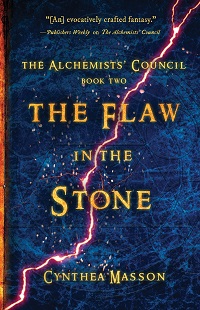| ________________
CM . . . . Volume XXIV Number 34. . . . May 4, 2018
excerpt:
The Flaw in the Stone is the second book in Cynthea Masson’s “Alchemists’ Council” series. The Flaw in the Stone is set before the first book in the series, The Alchemists’ Council, though it involves some of the same characters. Like the first book, it centres around two groups of semi-immortal beings who guide and influence the events of the world through alchemy. The two groups are constantly in conflict, with the Alchemists’ Council being in favor of more influence over the world and the Rebel Branch being in favor of less. The Alchemists’ Council had a straightforward plot, with a single protagonist and a linear timeline. Conversely, The Flaw in the Stone has a much more complex narrative. The timeline jumps around over the span of more than one hundred years, and there are many more characters who play prominent roles in the plot. This structure can make it difficult to keep track of what characters know and when they know it. Unlike the first novel, The Flaw in the Stone focuses on the actions of the Rebel Branch, providing more detail and context around events referenced in the first novel. The story focuses on the Rebel Branch as they uncover hidden secrets about a powerful bloodline that may help in their efforts to destabilize the Alchemists’ Council to restore balance to the world and ultimately increase free will. This series is well-constructed and original. Cynthea Masson does an excellent job of balancing the good and evil of her flawed characters. While the Alchemists’ Council and the Rebel Branch are adversaries, neither is depicted as having malicious intent. Rather, they disagree on fundamentals of the world, but the reader is able to see both the good and the bad points on either side. While the structure of the novels differ, and the second book does not follow the same main characters as the first novel, they are best read as companions. The Flaw in the Stone complements The Alchemists’ Council by telling some of the same story from a different perspective. Fans of The Alchemists’ Council will enjoy The Flaw in the Stone; new readers are advised to begin with the first novel in the series before reading The Flaw in the Stone. Recommended. Tara Stieglitz is a librarian at MacEwan University in Edmonton, AB.
Next Review |
Table of Contents for This Issue
- May 4, 2018. |
